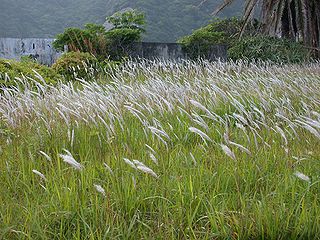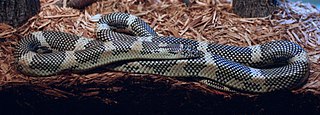Related Research Articles

The Africanized bee, also known as the Africanized honey bee and known colloquially as the "killer bee", is a hybrid of the western honey bee, produced originally by crossbreeding of the East African lowland honey bee (A. m. scutellata) with various European honey bee subspecies such as the Italian honey bee (A. m. ligustica) and the Iberian honey bee (A. m. iberiensis).

Lygodium is a genus of about 40 species of ferns, native to tropical regions across the world, with a few temperate species in eastern Asia and eastern North America. It is the sole genus in the family Lygodiaceae in the Pteridophyte Phylogeny Group classification of 2016. Alternatively, the genus may be placed as the only genus in the subfamily Lygodioideae of a more broadly defined family Schizaeaceae, the family placement used in Plants of the World Online as of November 2019.

The lovebug is a species of march fly found in parts of Central America and the southeastern United States, especially along the Gulf Coast. It is also known as the honeymoon fly or double-headed bug. During and after mating, matured pairs remain together, even in flight, for up to several days.

The Burmese python is one of the largest species of snakes. It is native to a large area of Southeast Asia and is listed as Vulnerable on the IUCN Red List. Until 2009, it was considered a subspecies of Python molurus, but is now recognized as belonging to a distinct species. It is an invasive species in the southeastern United States as a result of the pet trade.

The American crocodile is a species of crocodilian found in the Neotropics. It is the most widespread of the four extant species of crocodiles from the Americas, with populations present from South Florida and the coasts of Mexico to as far south as Peru and Venezuela.

Citrus greening disease is a disease of citrus caused by a vector-transmitted pathogen. The causative agents are motile bacteria, Candidatus Liberibacter spp. The disease is vectored and transmitted by the Asian citrus psyllid, Diaphorina citri, and the African citrus psyllid, Trioza erytreae, also known as the two-spotted citrus psyllid. It has also been shown to be graft-transmissible. Three different types of HLB are currently known: The heat-tolerant Asian form, and the heat-sensitive African and American forms. The disease was first described in 1929 and first reported in China in 1943. The African variation was first reported in 1947 in South Africa, where it is still widespread. Eventually, it affected the United States, reaching Florida in 2005. Within three years, it had spread to the majority of citrus farms. The rapid increase in this disease has threatened the citrus industry not only in Florida, but the entire US. As of 2009, 33 countries have reported HLB infection in their citrus crop.

Imperata cylindrica is a species of perennial rhizomatous grass native to tropical and subtropical Asia, Micronesia, Melanesia, Australia, Africa, and southern Europe. It has also been introduced to Latin America, the Caribbean, and the southeastern United States. It is a highly flammable fire-adapted species, and can spread rapidly by colonizing disturbed areas and encouraging more frequent wildfires.

Indotyphlops braminus, commonly known as the brahminy blind snake and other names, is a nonvenomous blind snake species found mostly in Africa and Asia, but has been introduced in many other parts of the world. They are completely fossorial animals, with habits and appearance similar to earthworms, for which they are often mistaken, although close examination reveals tiny scales rather than the annular segments characteristic of true earthworms. The species is parthenogenetic and all known specimens have been female. The specific name is a Latinized form of the word Brahmin. No subspecies are currently recognized.

Ctenosaura pectinata, commonly known as the Mexican spiny-tailed iguana, Guerreran spiny-tailed iguana, or the Mexican spinytail iguana, is a moderate-sized lizard endemic to western Mexico.

Cactoblastis cactorum, the cactus moth, South American cactus moth or nopal moth, is native to Argentina, Paraguay, Uruguay and southern Brazil. It is one of five species in the genus Cactoblastis that inhabit South America, where many parasitoids and pathogens control the expansion of the moths' population. This species has been introduced into many areas outside its natural range, including Australia, the Caribbean, and South Africa. In some locations, it has spread uncontrollably and was consequently classified an invasive species. However, in other places such as Australia, it has gained favor for its role in the biological control of cacti from the genus Opuntia, such as prickly pear.

The Institute of Food and Agricultural Sciences (IFAS) is an agriculture, life science, pathogen, and invasive species research facility in Florida affiliated with University of Florida. It is a partnership between federal, state, and county governments that includes an extension office in each of Florida's 67 counties, 13 research and education centers, several demonstration sites, the University of Florida College of Agricultural and Life Sciences and the School of Natural Resources and Environment), the Center for Tropical Agriculture, portions of the University of Florida College of Veterinary Medicine, the Florida Sea Grant program, and the International Program for Food, Agriculture and Natural Resources.
There are a number of environmental issues in Florida. A large portion of Florida is a biologically diverse ecosystem, with large wetlands in the Everglades. Management of environmental issues related to the everglades and the larger coastal waters and wetlands have been important to the history of Florida and the development of multiple parts of the economy of Florida, including the influential agricultural industry. This biodiversity leaves much of Florida's ecological ecosystem vulnerable to invasive species and human sources of industrial pollution and waste.

The Apalachicola kingsnake is a non-venomous species of kingsnake found in a small area of the Florida panhandle known as the Apalachicola Lowlands. Long argued as to whether or not it is a subspecies, the Apalachicola kingsnake was formerly named Lampropeltis getula goini. After years of research and many more specimens examined, in 2006 it was renamed to Lampropeltis getula meansi after D. Bruce Means, in recognition of his work on this subspecies.
Joe Roman is a conservation biologist, academic, and author of the books Whale and Listed: Dispatches from America's Endangered Species Act. His conservation research includes studies of the historical population size of whales, the role of cetaceans in the nitrogen cycle, the relationship between biodiversity and disease, and the genetics of invasions. He is the founding editor of "Eat the Invaders", a website dedicated to controlling invasive species by eating them.

Dr. Krishnaswamy VijayRaghavan FRS is an emeritus professor and former director of the National Centre for Biological Sciences. On 26 March 2018 the Government of India appointed him as the principal scientific adviser to succeed Dr. R Chidamabaram. In 2012 he was elected a fellow of The Royal Society and in April 2014 he was elected as a foreign associate of the US National Academy of Sciences. He was conferred the Padma Shri on 26 January 2013 and is also a recipient of the Infosys Prize in the life sciences category in 2009.
Karen Koch is a plant biologist in the horticultural science department in the University of Florida. She is a professor in the Plant Molecular and Cellular Biology (PMCB) Program, Horticultural Sciences Department, and Genetics Institute at University of Florida.

Kenneth Henry Wolfe is Professor of Genomic Evolution at University College Dublin (UCD), Ireland.

Neil John Gemmell, is a New Zealand geneticist. His research areas cover evolutionary genetics and genomics, molecular ecology, and conservation biology. Originally from Lower Hutt, he obtained his PhD at La Trobe University in Melbourne, Australia. Since 2008, Gemmell has been a professor at the University of Otago and since 2019 holds one of their seven Sesquicentennial Distinguished Chairs. Significant work includes the search of the Loch Ness Monster (2018) and the sequencing of the tuatara genome. In 2020, Gemmell received the Hutton Medal by the Royal Society Te Apārangi.
References
- ↑ "Human-eating monster crocodile may be Florida's newest invasive species". ScienceDaily. Retrieved 2020-07-30.
- ↑ "News and Media Relations - IFAS Communications - University of Florida - Institute of Food and Agricultural Sciences". ics.ifas.ufl.edu. Retrieved 2020-07-30.